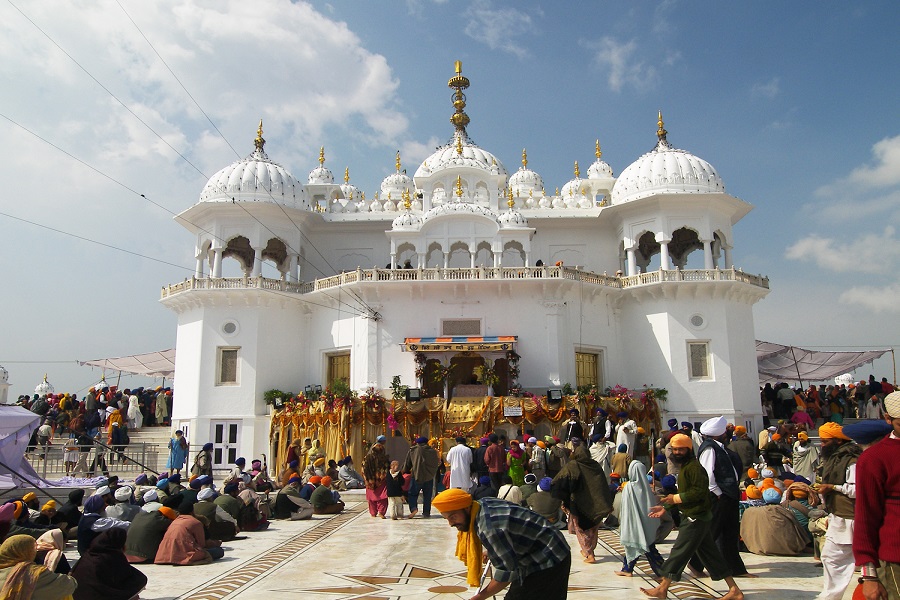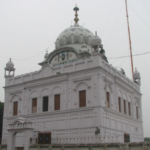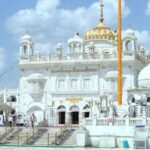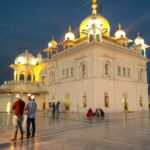Sikh temple Ramsar Sahib
The smallest of Amritsar’s five holy sarovars, the Ramsar Sarovar, is situated next to Gurdwara Ramsar. The current Gurdwara Ramsar is a modest, marble-lined hall with a gilded, fluted lotus dome on the southeastern side of the walled city of Amritsar, next to Chativind Gate.
The location of the old shrine was built in 1855, a considerable time before the current Gurdwara was completed. This location was chosen by Guru Arjun Dev, the fifth Sikh Guru, who was seeking a tranquil area away from the expanding city of Amritsar. Here, the Guru Granth Sahib would develop.
The site where the Adi Granth was written
The beloved Guru began compiling the hymns of the first four Gurus, Guru Nanak, Guru Angad, Guru Amar Das, and Guru Ram Das, in the year 1603, following the completion of the Harimandir Sahib in 1601. This spot was once isolated and shaded, about 1 km away from the bustle of the town growing around the Harmandar Sahib.
The Amrit Sarovar’s soothing breezes were far distant, despite the area’s abundance of cooling shade trees and the fact that it offered the Guru the necessary peace. To improve the environment, Guru Ji had a small tank constructed and gave it the name Ramsar in honor of his father Guru Ram Das. He spent more than a year there in relative seclusion with his scribe, Bhai Gurdas. Guruji supplemented the preceding Gurus’ teachings with his works as well as passages from many Hindu Sants and Muslim Pirs who all held the same Sikhism-related beliefs.
Finishing the Granth
The Adi Granth, also known as the First Book, was finished in 1604 and installed in the Harimandir Sahib with all due respect and ceremony. The holy Sikh text, the Guru Granth Sahib, is today known as the Adi Granth. Guru Gobind Singh appointed the Guru Granth Sahib, which currently has 1430 pages, as the Sikhs’ Eternal Guru just before he passed away.
This special holy book upholds the integrity of the scriptures while embracing the gurus’ thoughts for the ongoing instruction of Sikhism and other religions.
‘Psalm of Peace
Ramsar Sarovar
Additionally, Guru Arjan Dev Ji wrote his well-known Sukhmani at this location (the “Psalm of Peace”). It only makes sense that the location where the current, perpetual, and revered Sikh Guru, the Guru Granth Sahib Ji, was first created, is a site of special significance for all Sikhs since it marks the precise location of the Guru’s labors and the official beginning of the compilation of the Sikh scripture.
The Amritsar’s five holy ponds
In the Sikh holy city of Amritsar, there are a lot of important shrines. The five sacred pools in this city are particularly significant. Some Sikhs will take a swim in each of these five sacred ponds, which are known as sarovars. In addition to being a wonderful workout, the ritual also familiarises one with the significance of these five spots. These five holy Sarovars are Kaulsar (1627), Bibeksar (1586), Santokhsar (1587–88), Ramsar (1602-03), and Amritsar (today more commonly used to refer to the city than the Sarovar) (1628). Famous Gurdwara Ramsar is one of these five historical sanctuaries. This is situated south-southeast of the Sikhs’ most significant landmark, the Harminder Sahib. The Tenth Guru’s final instruction to the Sikhs was this. He ended the practice of apostolic succession and commanded the Sikhs to regard the Granth Sahib as their sole Guru going forward. Herein lies the significance of the location where Guru Arjun Dev assembled this holy book. The Sikhs have a great deal of regard for Gurudwara Ramsar.
On the southeast side of the walled city, close to Chativind Gate, Gurudwara Ramsar is located on the bank of the Ramsar Sarovar. Guru Arjan began compiling the Adi Granth, the Holy Book, today venerated as Guru Granth Sahib, when the Harimandar was finished. He picked a remote location for this assignment. The location chosen was a shaded nook that was a kilometer from the busy center of the town. He had a tank constructed and gave it the name Ramsar in honor of Guru Ram Das to make the surroundings more pleasant. Here, in the years 1603-04, Guru Arjan wrote the Adi Granth with Bhai Gurdas serving as his scribe, as well as his well-known Sukhmani, the Psalm of Peace. The location of the Guru’s labors is now marked by the Gurdwara Ramsar, a modest hall with a marble floor and a gilded, fluted lotus dome that was completed in 1855. The Ramsar Gurudwara, which is situated on the bank of the same-named pool, is one of the other well-known historical temples in Amritsar. To compose the sacred Adi Granth, Guru Arjun Dev and his brilliant savant scribe Bhai Gurdas spent a year or more in isolation here, which is located northeast of the Golden Temple.








